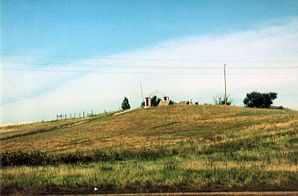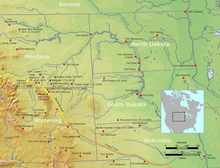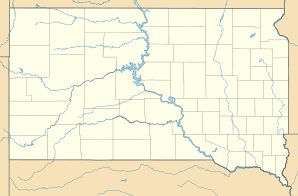Wounded knee
| Wounded knee | ||
|---|---|---|
 The Wounded Knee Cemetery, a memorial to the 1890 massacre |
||
| Location in the state | ||
|
|
||
| Basic data | ||
| State : | United States | |
| State : | South Dakota | |
| County : | Oglala Lakota County | |
| Coordinates : | 43 ° 9 ′ N , 102 ° 22 ′ W | |
| Time zone : | Central ( UTC − 6 / −5 ) | |
| Residents : | 382 (as of 2010) | |
| Population density : | 136.4 inhabitants per km 2 | |
| Area : | 2.8 km 2 (approx. 1 mi 2 ) of which 2.8 km 2 (approx. 1 mi 2 ) are land |
|
| Height : | 986 m | |
| Postal code : | 57794 | |
| Area code : | +1 605 | |
| FIPS : | 46-72900 | |
| GNIS ID : | 1265714 2393868, 1265714 | |
Wounded Knee (literal translation: wounded , also injured knee ) ( Lakota : Čaŋkpé Opí ) is a village in the Pine Ridge Reservation in the US state of South Dakota , named after a tributary of the White River , the Wounded Knee Creek . According to the US census of 2010 , it has 328 inhabitants and covers an area of 2.8 km². Wounded Knee was made famous through two historical events in the context of the Indian Wars and American Indian policy . In 1890, Wounded Knee became known through the massacre of the US Army of Lakota Indians, mainly members of the Minneconjou tribe (depending on the source with 150-350 victims); and in 1973 by the occupation of the place by activists of the American Indian Movement .
Massacre at Wounded Knee (Lakota Chankpe Opi Wakpala ) 1890

On December 29, 1890 killed soldiers of the US 7th Cavalry Regiment men, women and children of Minneconjou - Lakota - Sioux - Indians under Chief Spotted Elk (but often falsely also Big Foot named) at Wounded Knee. This massacre broke the last resistance of the Indians against the whites. This was preceded by the "ghost dance" movement of Wovoka , a prophet of the Paiuts . The ghost dance revitalization and redemption movement was aimed at all Indian tribes.
Successful dissemination of the teaching was viewed as a threat by the US government . Sitting Bull , Spotted Elk, and other chiefs were seen as potentially dangerous . Sitting Bull was killed on December 15, 1890.

Colonel James William Forsyth was ordered to deport the Sioux to a military camp in Omaha . The Sioux were first informed that they would have to hand over all firearms. Unsatisfied with the number of weapons they had volunteered, the soldiers began to search the tents. Forsyth was still unhappy with the result and ordered a body search . The Indians also put up with this - all except for the medicine man Yellowbird, who protested violently and danced a few steps of the ghost dance. Alarmed, the US soldiers continued to search. When they struck gold at Black Coyote, who had a new Winchester hidden under his clothes and refused to hand over the rifle - after all, he had paid a lot of money for it, and the US soldiers would have taken the rifle away for good - came it turned into a scramble in which a shot was released.
The US soldiers then began to fire. Shells fired from 42 mm Hotchkiss mountain cannons positioned on the hills killed numerous Indians. Chief Spotted Elk was among the dead. 25 cavalrymen also died, mostly killed by shells on their own side.
Forsyth was cleared of all guilt.
The writer Lyman Frank Baum was probably not too far from public opinion of his time when he only complained about the dead US soldiers in the Aberdeen Saturday Pioneer of January 3, 1891, but called for their "total extinction" in relation to the conflict with the Indians:
“The curious policy of the government to use such a weak and wavering person as General Miles to monitor the troubled Indians has resulted in a terrible bloodshed among our soldiers (…) There has been ample time for swift and decisive action to prevent this disaster would have. (This newspaper) previously stated that our security depends on the total annihilation of the Indians. After having wronged them for centuries, let us follow up with yet another wrong and wipe these untamed and untamable creatures from the face of the earth (...) Otherwise, we can expect that the years to come will be as full of trouble with the redskins as they are the past. "
In the 20th century, the view of events changed. In particular, the 1970 non-fiction book Bury My Heart at Wounded Knee (" Bury my heart at the bend of the river ") by Dee Brown described the massacre as the culmination of the genocide of the Indian population of the Great Plains.
The site of the event was granted National Historic Landmark status in December 1965 . Since October 1966, she is known as Wounded Knee Battlefield in National Register of Historic Places entered.
Cast of Wounded Knee 1973
On February 27, 1973, members of the American Indian Movement (AIM) militant Indian group occupied Wounded Knee and took eleven hostages. With the action they wanted to achieve the removal of the tribal chairman of Pine Ridge, Dick Wilson . Thanks to the good media work of the AIM, many reporters from American and international media were on the scene and reported daily for a worldwide audience.
When the demand for the removal of the elected government of Pine Ridge, which was suspected of corruption and nepotism, was unsuccessful and the FBI instead drew a siege ring around the occupiers in Wounded Knee, they finally called after several failed negotiations with a deputy attorney general of the USA the independent Oglala nation. The occupation lasted 71 days. On May 8th, the insurgents capitulated after the fire, which flared up especially at night, by a large contingent of FBI agents and the National Guard on April 26th, 1973 led to the death of Oglala Lakota Buddy Lamont by a sniper. There were other casualties during the operation and about sixty deaths in the years after when Dick Wilson and his supporters took bloody revenge.

To support the indigenous cause during the siege of Wounded Knee, the actor refused Marlon Brando to him for his role in The Godfather awarded Oscar from. In his place, Dingen Littlefeather appeared at the awards ceremony in traditional Apache clothing and said Brando would not accept the award because of the "poor treatment of Native Americans by the film industry."
After the end of the occupation, many of the AIM activists and their supporters were charged and many were sentenced to prison terms. Marlon Brando took part in the trials as an observer to provide effective public support to the defendants - including AIM leaders Dennis Banks and Russell Means .
music
- In 1973 the rock group Redbone released their hit We Were All Wounded at Wounded Knee ; some of the members of Redbone also had Indian ancestors.
- Buffy Sainte-Marie's album Coincidence and Likely Stories with the song Bury My Heart at Wounded Knee was released 19 years later .
- Furthermore, the American singer Dean Reed released a long-playing record in 1980 in the ČSSR , the GDR and the USSR , on which his title Wounded Knee In 73 appeared, in which he dealt with the events of 1973.
- The American country singer Johnny Cash dealt with the fall of the Indian tribes in his album Bitter Tears . He processed the massacre at Wounded Knee and the death of Chief Big Foot in a song entitled Big Foot on his 1972 album America .
- The German psychedelic rock band Gila released their last of three long-playing records in 1973 under the title Bury My Heart at Wounded Knee .
- The German folk-rock band Ape, Beck & Brinkmann released a song on their LP Rainbowland in 1982 with the title Wounded Knee , in which they also referred to the living conditions of today's Indians.
- The American heavy metal band Manowar released the song Spirit Horse of the Cherokee on their album The Triumph of Steel , which deals with the battle of the Wounded Knee.
- The English musician Nik Kershaw also released a song on the album The Works called Wounded Knee .
literature
- Dee Alexander Brown: Bury my heart at the bend of the river . Knaur, Munich 2005, ISBN 978-3-426-62804-1 (American English: Bury My Heart at Wounded Knee. An Indian History of the American West . Translated by Helmut Degner, Knaur-Taschenbuch 62804).
- William SE Coleman: Voices of Wounded Knee. University of Nebraska Press, Lincoln, NE 2000, ISBN 0-8032-6422-4 (English).
Web links
- Massacre at the Wounded Knee: blood stained the prairie , one day , November 29, 2015
- Wounded Knee Museum , English
- About the wounded knee massacre , description of the wounded knee massacre of 1890 and its background / context, English
- In the Shadow of Wounded Knee , National Geographic , August 2012, English
- Massacre 125 years ago: 300 dead Indians on Wounded Knee Deutschlandfunk December 29, 2015
Individual evidence
- ^ Jan F. Ullrich: New Lakota Dictionary , 2nd. Edition, Lakota Language Consortium, Bloomington, IN 2014, ISBN 978-0-9761082-9-0 . Archived from the original on October 18, 2016 Info: The archive link was inserted automatically and has not yet been checked. Please check the original and archive link according to the instructions and then remove this notice. (Accessed July 3, 2016).
- ^ L. Frank Baum's Editorials on the Sioux Nation ( Memento of May 1, 2008 in the Internet Archive ); Northern State University, Aberdeen, South Dakota, USA
- ↑ Listing of National Historic Landmarks by State: South Dakota. National Park Service , accessed February 17, 2020.
- ↑ Wounded Knee Battlefield on the National Register of Historic Places , accessed February 17, 2020.
- ↑ We are here to stay! Part 5: "Wounded Knee". Documentary series. Arte , February 27, 2010.

